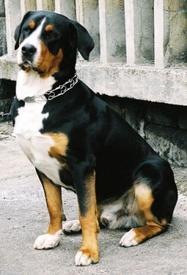
Swiss herding dogs, classified into four breeds, include the Bernese Mountain Dog - particularly favoured in the UK - the Entlebucher Cattle Dog and the Appenzell Cattle Dog. The fourth variety, the Greater Swiss Mountain Dog, is most similar in appearance and structure to the Bernese, and is the largest of the four varieties. Believed to have originated with the Roman invasion of Switzerland some 2,000 years ago, the Greater Swiss Mountain Dog is the result of crossing between Mastiff-type dogs that accompanied the invaders and native Swiss herding dogs. With the advent of industrialisation, the Greater Swiss was no longer needed and numbers greatly diminished. Originally used to pull carts, guard property and work flocks, the versatility of the breed could not compete with the industrial and mechanical rise and facing extinction, the breed was resurrected thanks to the efforts of Dr. Albert Heim.
As with the Bernese Mountain Dog, the Greater Swiss is considered one of the most beautiful breeds, possessing a dense, tricolour coat in rich colour variations of black, white and rust. Besides this, the breed is recognised for its high-set triangular ears, strong, straight muzzle and proportionate body. A working dog by nature, the modern Greater Swiss Mountain Dog is popularly employed in tracking and herding, search and rescue, competitive obedience, and guarding. Despite its inherent instincts to guard and herd, the breed does not exercise a loud or incessant bark, but remains actively vigilant to change and threat.
A dog of impressive size and stature, the Greater Swiss Mountain Dog weighs a healthy average of 59-61 kg with discrepancies across gender. The life expectancy of the breed is approximately 10 years, although there are great variations and this figure is entirely dependent on care shown. A great breed choice for compatibility with children, the Greater Swiss Mountain Dog is gentle, obedient to instruction, companionable and playful, whilst being inherently protective of its family.
Generally a healthy and resilient breed, the Greater Swiss Mountain Dog is susceptible to a number of breed-specific health complaints, including cancer, mast-cell tumours, hip and elbow dysplasia and eyelid problems. Gastric tortion and bloat, potentially fatal conditions if left untreated for too long, as well as cardiac and orthopedic problems are commonly associated with the large breeds. Additionally, the Greater Swiss is prone to easy weight gain, so feeding your dog human foods is not encouraged for this reason.
Do you own a Greater Swiss Mountain Dog? Let others know what they're like!
Related products
Advantage 80 Spot On Flea Control Large Cats and Rabbits
from £12.95
Advantage 40 Spot On Flea Control Cats, Small Dogs and Rabbits
from £12.95
Advantage 100 Spot On Flea Control Medium Dog
from £12.95
Advantage 250 Spot On Flea Control Large Dog
from £12.95
Drontal Tasty Bone Wormer Tablets for Small & Medium Dogs (2 to 20kg)
from £2.15
FRONTLINE Plus Flea & Tick Treatment Dogs & Cats
from £17.49
TermaWorm™ Tablets for Cats & Dogs
from £1.59
Drontal Tasty Bone XL Wormer Tablets for Large Dogs (Over 20kg)
from £6.39